Sending thousands, or even millions, of emails requires a powerful and reliable engine. Your success depends on ensuring messages land in the inbox, not the spam folder. The world of bulk email services is vast, with options ranging from developer-focused APIs like Amazon SES and SendGrid to all-in-one marketing platforms like Mailchimp and Brevo. Choosing the right one is critical for protecting your sender reputation, maximizing campaign ROI, and ensuring you can scale your operations without technical hurdles.
This guide cuts through the noise to analyze the 12 best bulk email services available today. We move beyond marketing jargon to provide a practical breakdown of each platform. You'll find a detailed look at their unique strengths, potential limitations, and the specific use cases where they excel. Our goal is to help you select a provider that truly matches your technical requirements and strategic marketing goals.
For each service on our list, we provide a hands-on review, complete with screenshots and direct links, so you can see exactly how it works. We’ll cover key aspects like deliverability infrastructure, API flexibility, and pricing models to give you a complete picture. Of course, the best tool is only as good as the strategy behind it. Beyond simply choosing a service, understanding effective cold outreach techniques is vital for maximizing your campaign's success. This comprehensive resource is designed to equip you with the knowledge needed to make a confident and informed decision for your business.
1. Amazon Simple Email Service (SES)
Amazon Simple Email Service (SES) is a cloud-based email service built for developers and digital marketers who need to send high volumes of transactional and marketing emails. Unlike all-in-one platforms, SES is a powerful, no-frills infrastructure tool focused purely on email delivery. It stands out for its unparalleled scalability and cost-efficiency, making it a top choice for businesses with large-scale sending needs integrated within the AWS ecosystem.
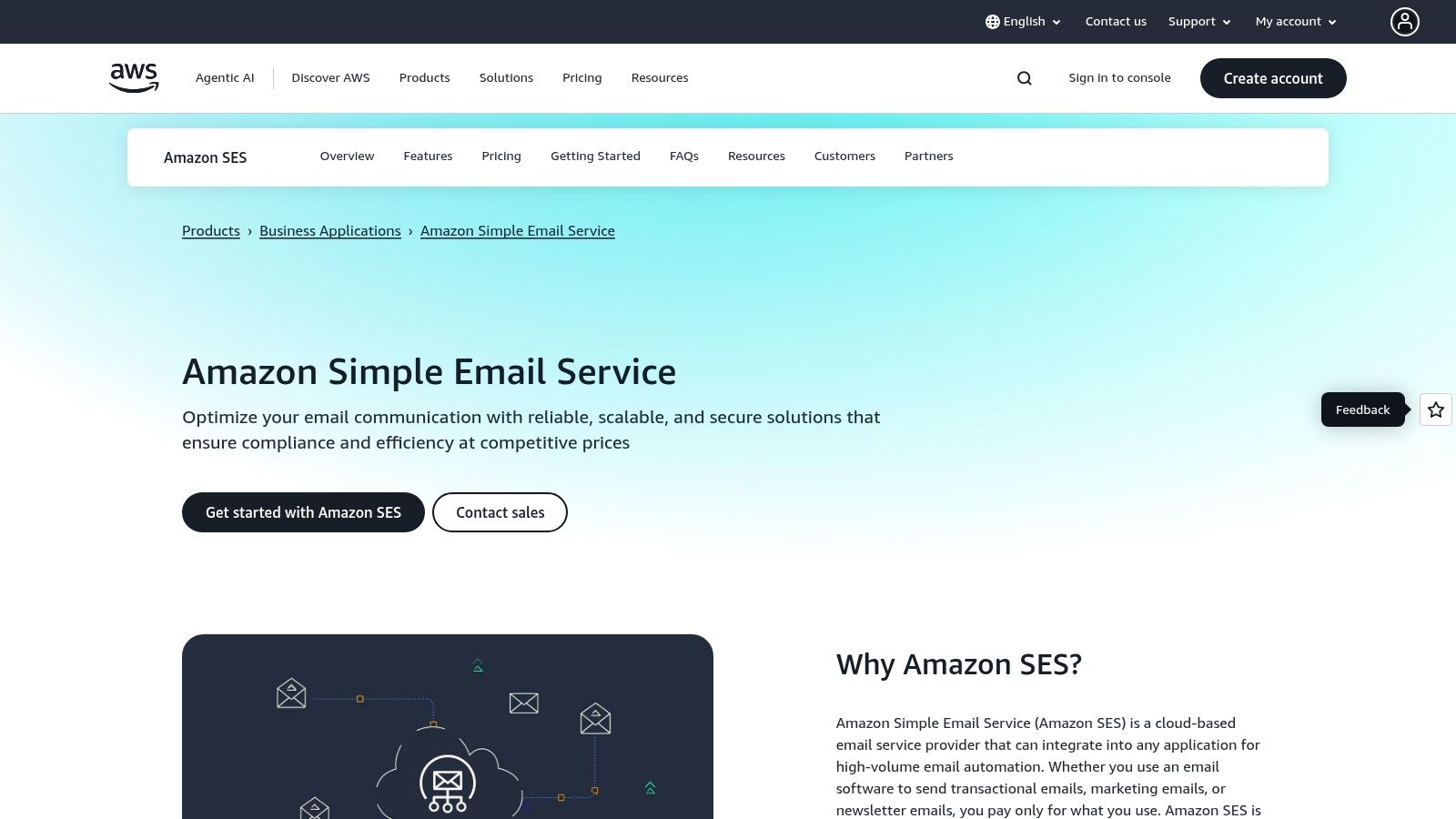
The platform is designed for technical users who require granular control and are comfortable managing their own sending environment. You won't find a drag-and-drop campaign builder here; instead, you get a robust API to integrate sending capabilities directly into your applications or third-party marketing tools. Integrating a valid email API for better results is also a common practice to ensure list hygiene before sending through SES.
Key Features and Considerations
The primary appeal of SES is its pay-as-you-go pricing model, which is among the lowest in the industry. Users only pay for what they send, plus minimal costs for data and optional add-ons like dedicated IP addresses. This makes it one of the best bulk email services for businesses looking to optimize their sending costs without sacrificing reliability.
Best For:
- Developers and technical teams integrating email into applications.
- High-volume senders who prioritize cost over a user-friendly interface.
- Businesses already using the AWS ecosystem.
| Feature | Details |
|---|---|
| Pricing Model | Pay-as-you-go; extremely low cost per 1,000 emails. |
| Primary Use Case | Transactional emails (receipts, alerts) and API-driven marketing campaigns. |
| Technical Skill Required | High; requires DNS, IAM, and API integration knowledge. |
| Deliverability Tools | Virtual Deliverability Manager, dedicated IPs, and reputation monitoring. |
Pros:
- Exceptionally low unit costs at scale.
- Highly reliable and scalable, built on AWS infrastructure.
- Fine-grained control over sending configurations.
Cons:
- Requires significant technical expertise to set up and manage.
- No built-in visual campaign builder or marketing automation tools.
Website: https://aws.amazon.com/ses/
2. Twilio SendGrid
Twilio SendGrid is a leading cloud-based email delivery platform trusted by developers and marketers for both transactional and marketing emails. It strikes a balance between the raw infrastructure of services like SES and the user-friendly nature of all-in-one marketing suites. SendGrid is renowned for its reliable delivery, robust API, and detailed analytics, making it one of the best bulk email services for businesses that need both programmatic control and marketing campaign management.
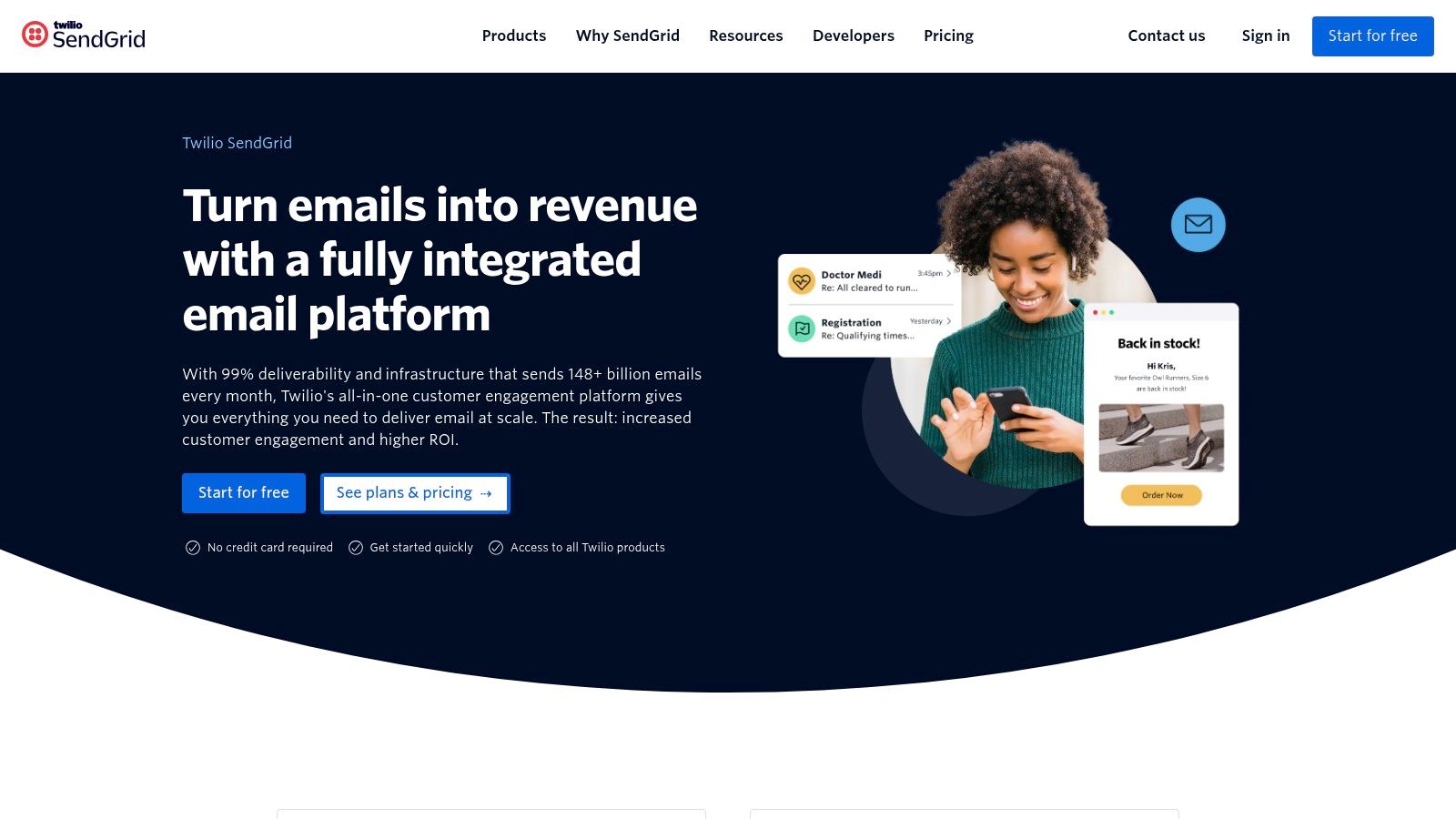
The platform is split into two core offerings: the Email API for developers to send emails via SMTP or API, and Marketing Campaigns for marketers to design and manage newsletters and automated sequences. This dual approach allows technical teams to handle transactional sends while marketing teams can operate independently, all within a single, scalable ecosystem. Its extensive documentation and large community make getting started relatively straightforward.
Key Features and Considerations
SendGrid’s primary advantage is its mature and well-documented API, which integrates seamlessly into countless applications. The platform offers a generous free plan for testing and low-volume sending, with paid tiers that scale to support businesses sending millions of emails. Features like event webhooks, dynamic templates, and integrated email validation provide a comprehensive toolset for managing sophisticated email programs.
Best For:
- Businesses needing a blend of powerful API and user-friendly marketing tools.
- Startups and developers looking for a scalable solution with a free entry point.
- Marketers who require strong analytics and deliverability insights.
| Feature | Details |
|---|---|
| Pricing Model | Tiered monthly plans based on email volume, with a free plan available. |
| Primary Use Case | Transactional emails, API-driven notifications, and marketing campaigns. |
| Technical Skill Required | Low to moderate; API requires developer skill, but Marketing Campaigns is user-friendly. |
| Deliverability Tools | Reputation monitoring, dedicated IPs (on higher tiers), and ISP outreach. |
Pros:
- Mature and well-documented API with a large ecosystem.
- Easy to get started with and scales effectively.
- Broad set of integrations with other platforms and services.
Cons:
- Advanced features like dedicated IPs require higher-priced tiers.
- Costs can escalate with add-ons and high-volume overages.
Website: https://sendgrid.com/
3. Mailgun
Mailgun is a developer-focused email API service designed for businesses that need reliable, high-volume transactional and marketing email delivery. Much like SES, it provides a powerful infrastructure for sending, receiving, and tracking emails programmatically. It stands out by offering advanced features like inbound email parsing and detailed analytics, positioning itself as a robust toolkit for developers building sophisticated email functionalities into their applications.
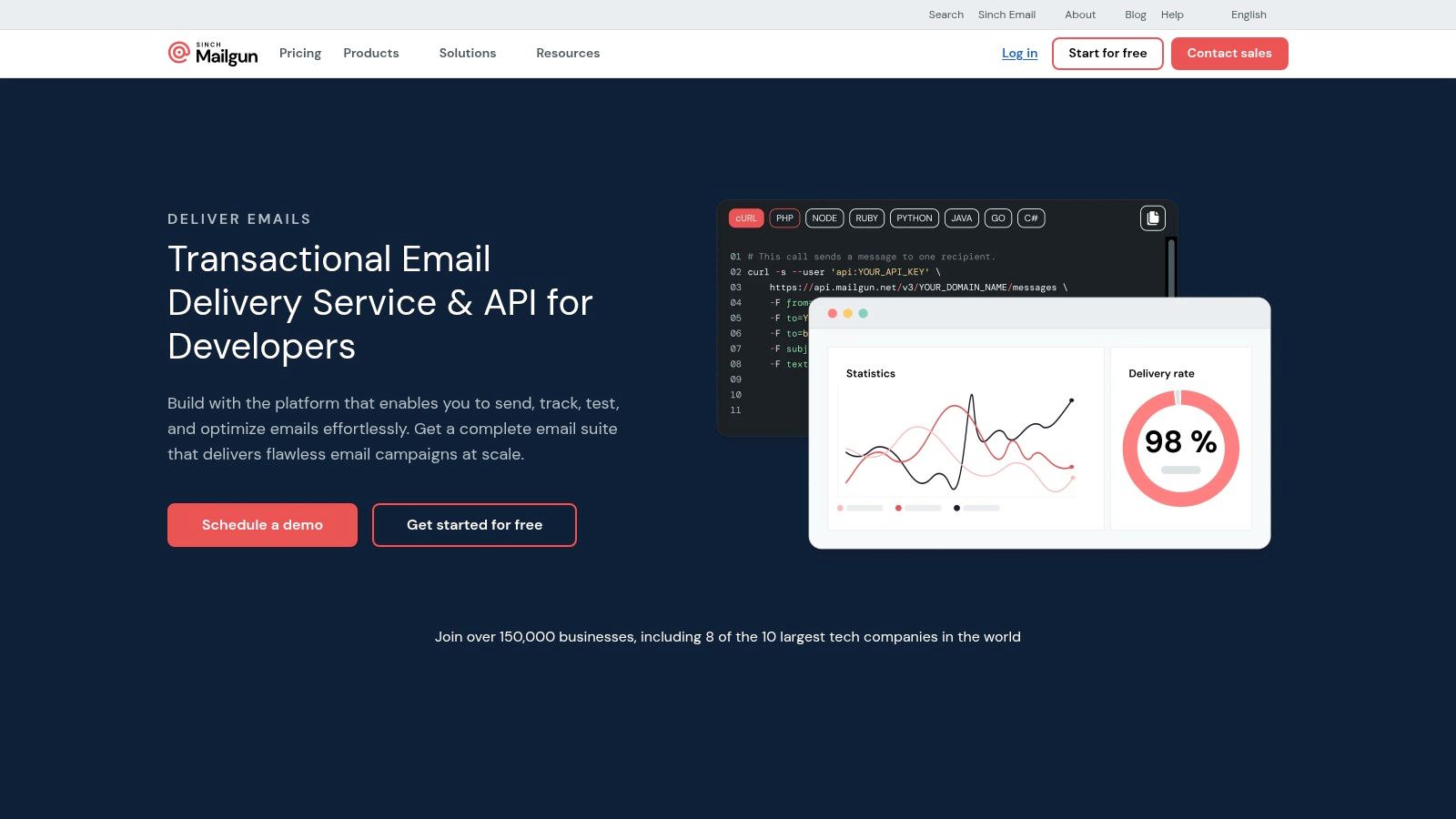
The platform is built around its RESTful API and SMTP relay, giving technical teams granular control over their email streams. While it doesn't offer a traditional drag-and-drop editor, its value lies in its strong deliverability and comprehensive logging capabilities. It also encourages best practices like list hygiene; integrating email validation tools to reduce bounce rates is a common step before sending large campaigns.
Key Features and Considerations
Mailgun’s core strength is its flexibility and powerful feature set for developers. Features like inbound routing allow applications to automatically process incoming emails, while webhooks provide real-time updates on delivery events. This makes it one of the best bulk email services for applications requiring two-way email communication and immediate feedback on sending performance.
Best For:
- Developers needing a powerful email API for their applications.
- Businesses sending high volumes of transactional messages.
- Teams that require inbound email processing and detailed analytics.
| Feature | Details |
|---|---|
| Pricing Model | Tiered subscription plans based on volume, with a free trial available. |
| Primary Use Case | API-driven transactional emails and automated marketing messages. |
| Technical Skill Required | High; familiarity with APIs, SMTP, and DNS settings is necessary. |
| Deliverability Tools | Email validation, dedicated IPs, send time optimization, and log retention. |
Pros:
- Strong programmatic sending and inbound email parsing capabilities.
- Clear and scalable pricing tiers with no daily sending caps on paid plans.
- Detailed analytics and logs for easy troubleshooting.
Cons:
- User interface is developer-centric, not designed for non-technical marketers.
- Some advanced features are only available in higher-tier subscription plans.
Website: https://www.mailgun.com/
4. Brevo (formerly Sendinblue)
Brevo, formerly known as Sendinblue, is a comprehensive all-in-one marketing platform that extends beyond just email. It integrates email, SMS, WhatsApp, and chat into a single hub, making it an excellent choice for businesses looking to manage multiple communication channels without juggling different tools. Unlike purely technical services, Brevo offers a user-friendly interface with powerful automation features, positioning itself as one of the best bulk email services for small and medium-sized businesses.
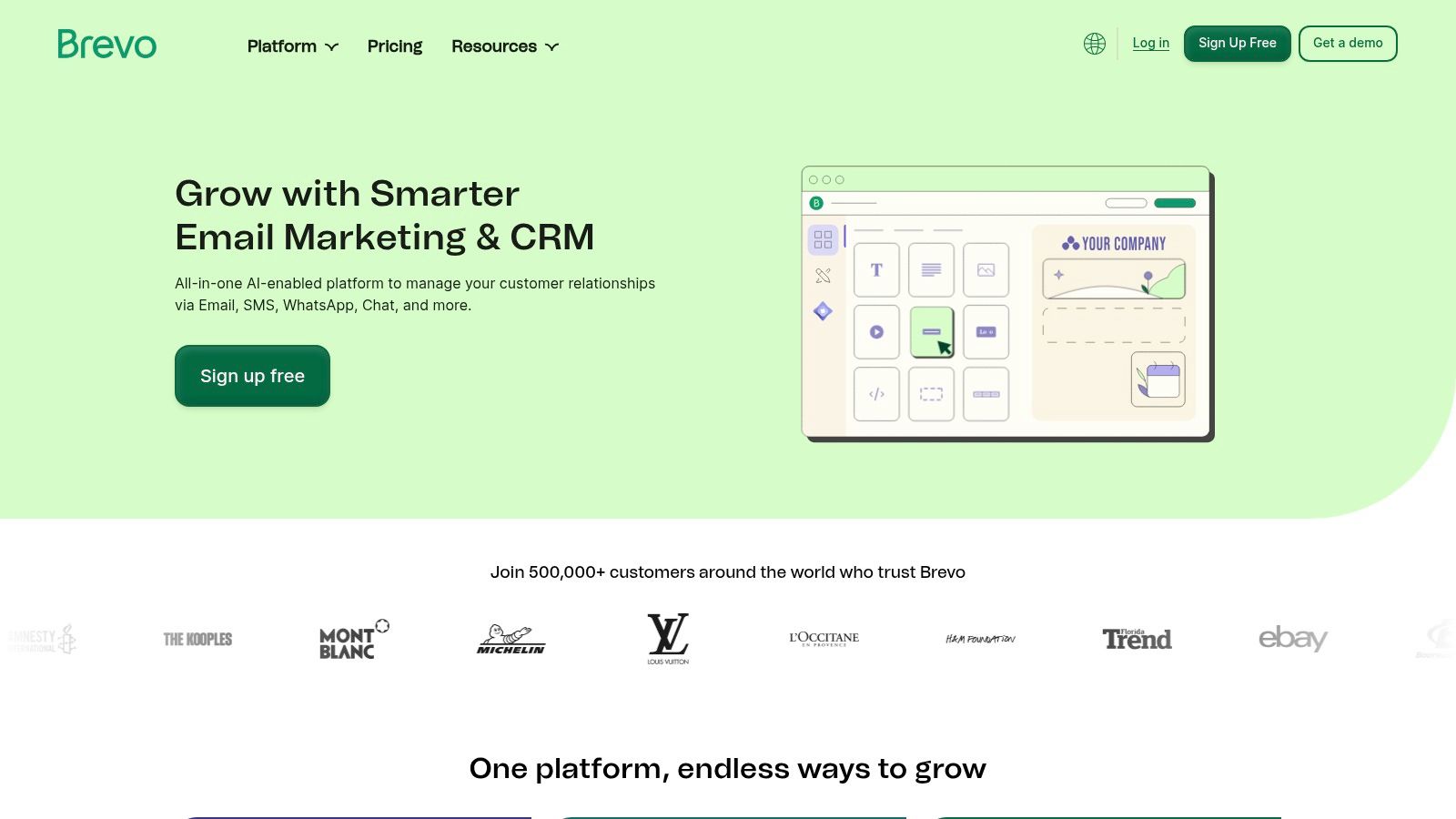
The platform is designed for marketers who need a balance of functionality and affordability. It provides a generous free tier and flexible pricing, including prepaid email credits for sporadic campaigns and a dedicated Messaging API for developers. This versatility allows businesses to start small and scale their marketing efforts, from simple newsletters to complex, multi-channel automated workflows, all within one ecosystem.
Key Features and Considerations
Brevo's strength lies in its combination of a feature-rich marketing suite with accessible pricing. The platform’s pricing is primarily based on the number of emails sent rather than the number of contacts, which can be highly cost-effective for businesses with large lists but moderate sending frequencies. Higher-tier plans unlock advanced features like A/B testing, landing pages, and remove Brevo's branding.
Best For:
- Small to medium-sized businesses needing an all-in-one marketing solution.
- Marketers looking for powerful automation at an affordable price point.
- Companies wanting to integrate email, SMS, and WhatsApp campaigns.
| Feature | Details |
|---|---|
| Pricing Model | Send-based plans, prepaid credits, and a generous free tier. |
| Primary Use Case | Integrated marketing campaigns, SMB email automation, and transactional API. |
| Technical Skill Required | Low to moderate; intuitive for marketers, with API options for developers. |
| Deliverability Tools | Dedicated IPs on higher plans, send-time optimization, and detailed reports. |
Pros:
- Affordable entry pricing with a generous free plan.
- Strong marketing automation and segmentation tools for SMBs.
- Multichannel capabilities including SMS and WhatsApp.
Cons:
- The free plan includes Brevo branding and has a daily sending cap.
- Advanced features for enterprise use can become costly.
Website: https://www.brevo.com/
5. Sinch Mailjet
Sinch Mailjet is an email service provider that effectively bridges the gap between developer-focused APIs and user-friendly marketing platforms. It offers a powerful email API and SMTP relay for transactional sends, but also includes a collaborative drag-and-drop email editor. This unique combination makes it one of the best bulk email services for teams where developers and marketers need to work together on email campaigns.
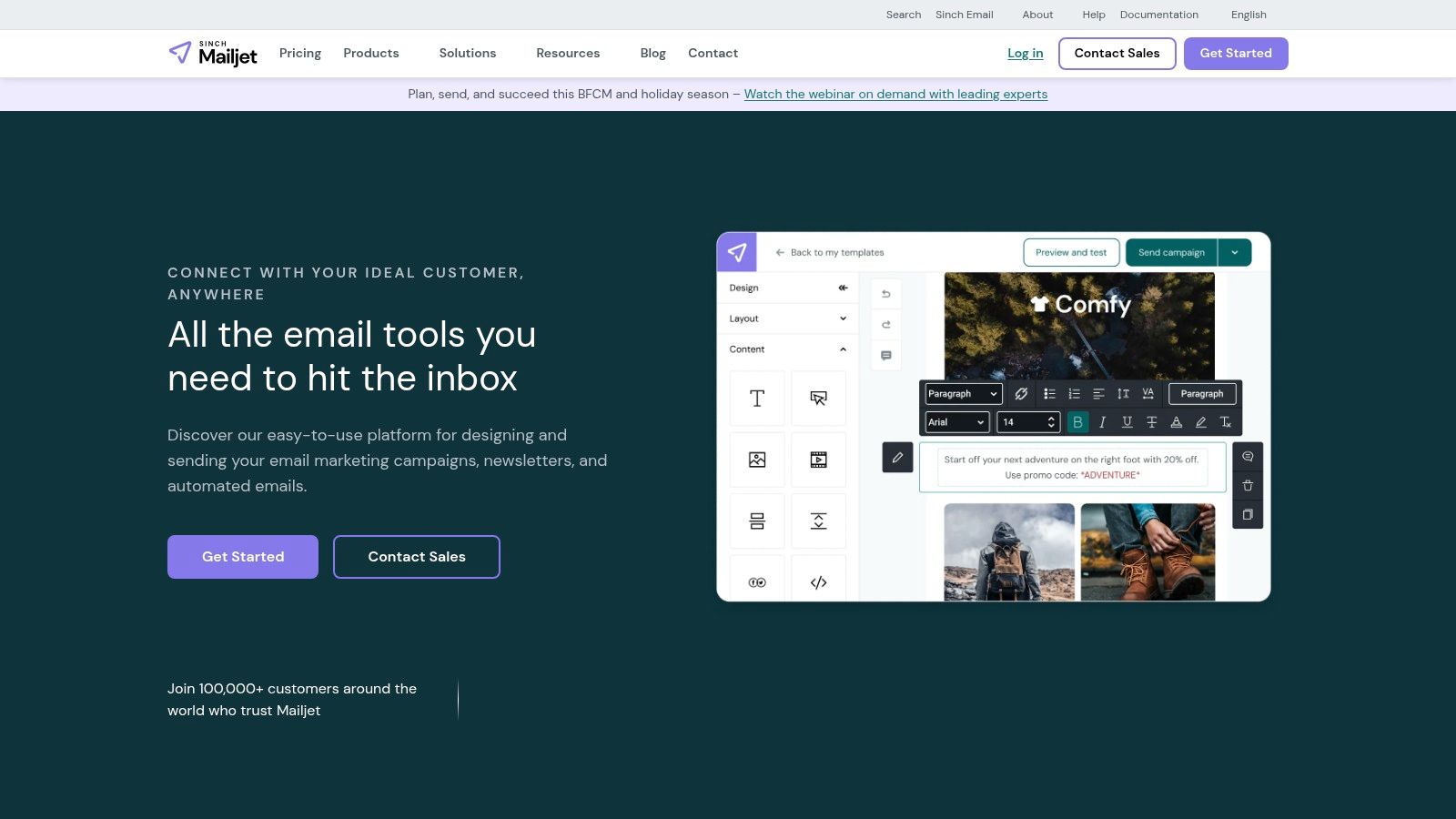
The platform is designed with teamwork in mind, featuring real-time collaboration, user permissions, and subaccounts to manage different clients or projects separately. This allows marketers to design templates, developers to integrate the sending logic, and managers to review analytics, all within a single, cohesive environment. Its free tier is also generous, offering 6,000 emails per month for users to get started.
Key Features and Considerations
Mailjet’s pricing is straightforward, with simple sliders that adjust based on email volume, and paid plans have no daily sending limits. This predictable cost structure is beneficial for businesses scaling their email marketing efforts. The platform provides essential tools like segmentation, A/B testing, and detailed analytics to help optimize campaign performance and deliverability.
Best For:
- Marketing and development teams that need to collaborate on email campaigns.
- Businesses looking for a balance between technical API features and a visual editor.
- Agencies managing email campaigns for multiple clients via subaccounts.
| Feature | Details |
|---|---|
| Pricing Model | Tiered plans based on monthly email volume; generous free plan available. |
| Primary Use Case | Collaborative marketing campaigns and transactional email sending. |
| Technical Skill Required | Low to medium; intuitive for marketers, powerful for developers. |
| Deliverability Tools | Segmentation, validation tools, analytics, and dedicated IPs on higher plans. |
Pros:
- Excellent collaboration features for teams.
- Combines a robust API with an easy-to-use email editor.
- Simple and predictable pricing structure.
Cons:
- The free plan has a daily sending cap and includes Mailjet branding.
- Advanced deliverability features are reserved for more expensive tiers.
Website: https://www.mailjet.com/
6. Elastic Email
Elastic Email is a versatile and cost-efficient email platform offering two distinct products: an Email API for developers sending transactional messages and an all-in-one Email Marketing suite for marketers. It has carved out a niche by providing robust sending infrastructure at highly competitive prices, making it an attractive option for startups, small businesses, and high-volume senders focused on maximizing their ROI.
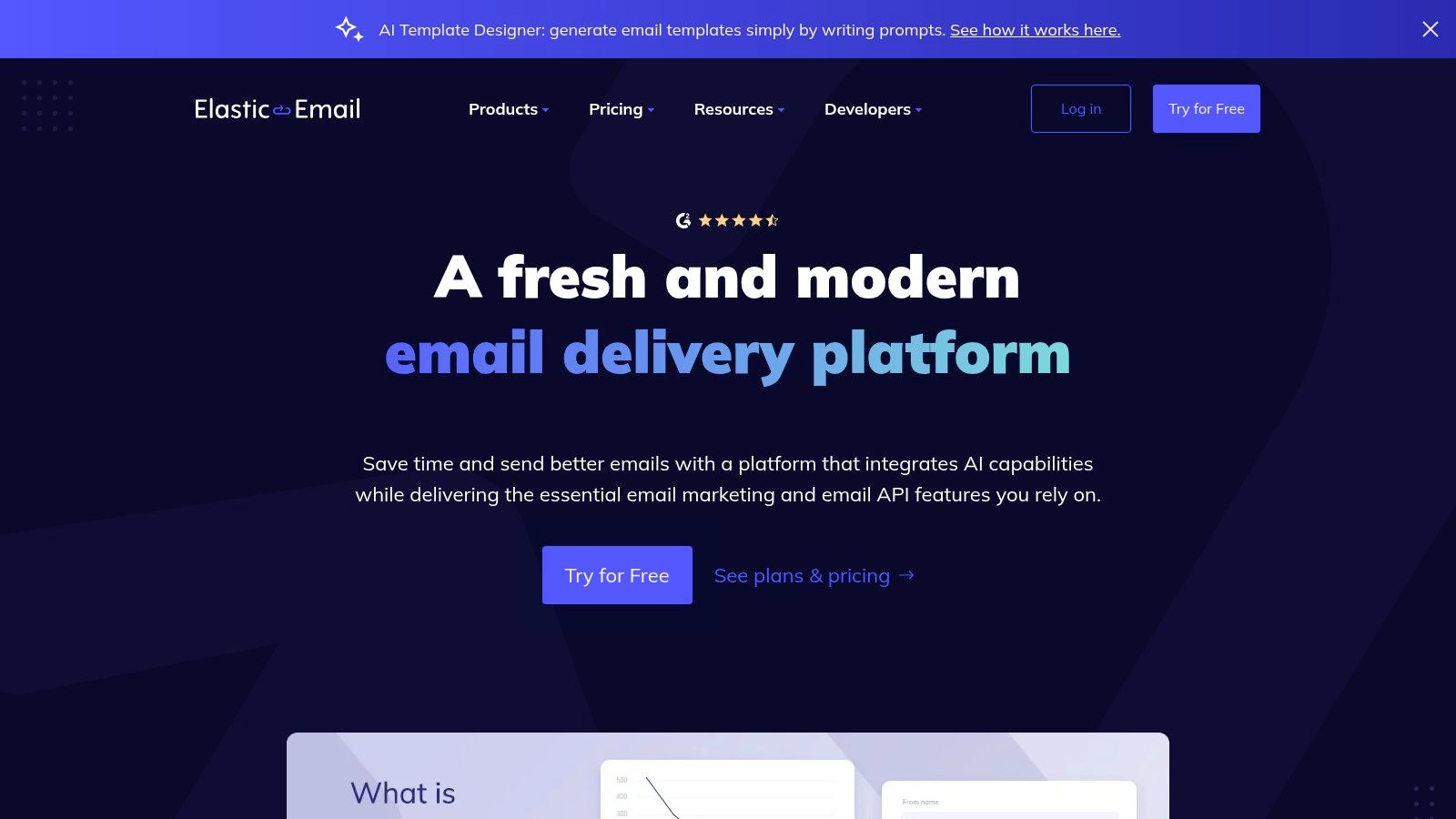
The platform distinguishes itself with features typically found in more expensive services, such as built-in email verification tools to help maintain list quality. This focus on hygiene is critical, and a comprehensive guide to email list cleaning can complement its native tools for optimal deliverability. While powerful, its interface and documentation are more functional than polished, appealing to users who prioritize affordability and core features over an enterprise-level user experience.
Key Features and Considerations
Elastic Email’s pricing is one of its strongest selling points, offering generous email volumes for a fraction of the cost of many competitors. New accounts start with a lower sending capacity that increases as they build a positive sending reputation, a measure designed to protect the platform's deliverability. This makes it one of the best bulk email services for budget-conscious businesses that can gradually scale their sending activities.
Best For:
- Startups and small businesses needing an affordable, all-in-one solution.
- Developers looking for a low-cost, reliable Email API.
- High-volume senders who can manage their sending reputation carefully.
| Feature | Details |
|---|---|
| Pricing Model | Tiered plans for Marketing; pay-as-you-go for Email API. |
| Primary Use Case | Transactional and marketing emails for cost-sensitive users. |
| Technical Skill Required | Low for Marketing suite; Moderate for API integration. |
| Deliverability Tools | Built-in email verification, sub-accounts, and optional dedicated IPs. |
Pros:
- Extremely competitive pricing, especially for high-volume sends.
- Includes email verification tools in its Pro plans.
- Flexible options with separate API and marketing platforms.
Cons:
- New accounts face initial sending limits that must be increased over time.
- The interface and documentation are less polished than some competitors.
Website: https://elasticemail.com/
7. Postmark (by ActiveCampaign)
Postmark is an email delivery service built from the ground up with a laser focus on deliverability and speed, particularly for transactional and application-driven emails. Acquired by ActiveCampaign, it operates on a philosophy of separating different email types to protect sender reputation. It routes marketing and transactional messages through distinct infrastructure, ensuring that a high-volume broadcast campaign doesn't negatively impact the delivery of critical password resets or receipts.
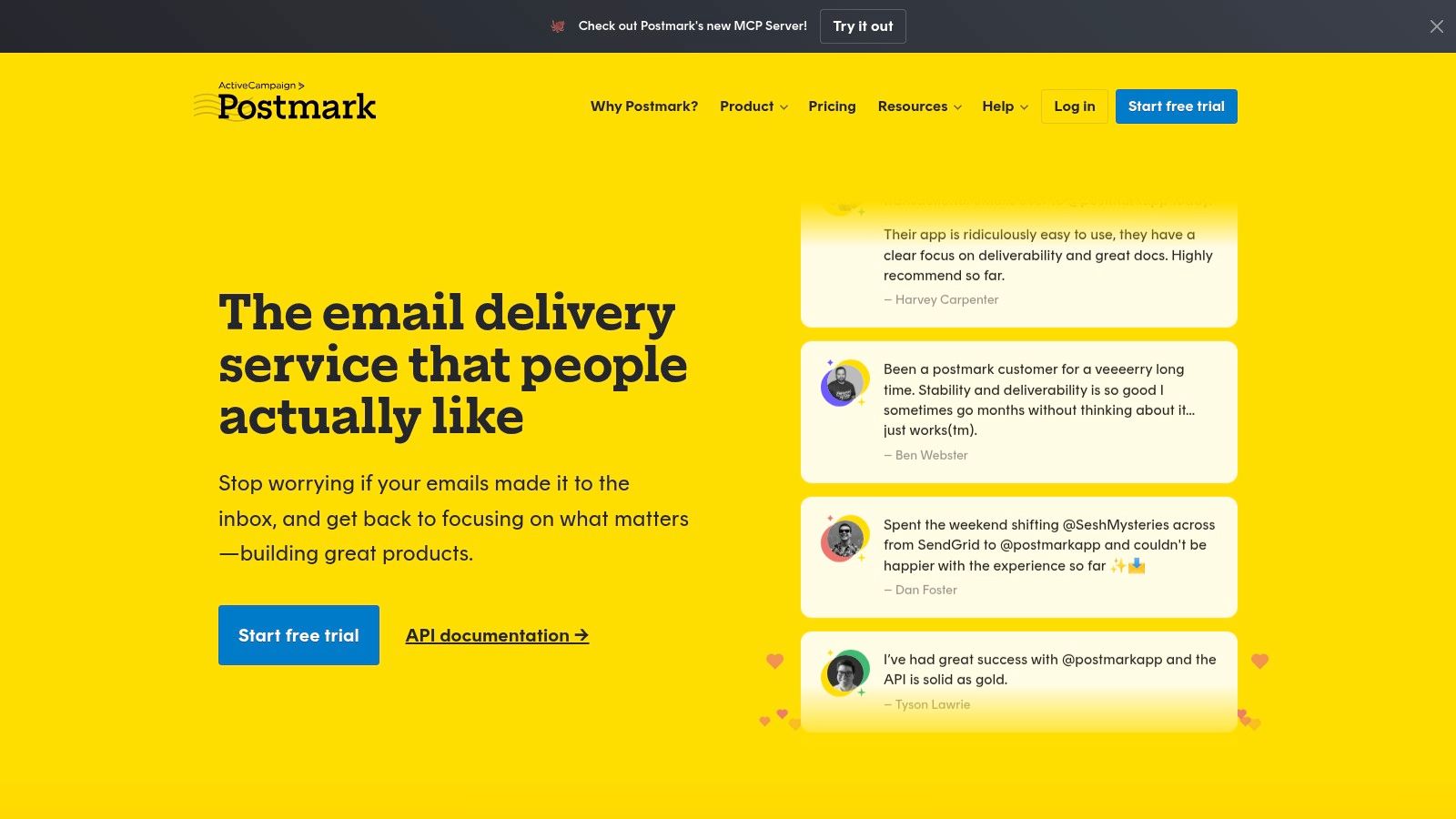
This developer-first approach means Postmark is primarily an API-driven service, designed for seamless integration into applications. While it offers a clean user interface for managing templates and viewing detailed activity logs, its core strength lies in its reliable backend. The platform provides extensive documentation and a robust API, making it a favorite among developers who need a "set it and forget it" solution for email delivery.
Key Features and Considerations
Postmark’s unique selling proposition is its segregated email streams. This technical separation is a key reason it’s considered one of the best bulk email services for applications that depend on high inbox placement for crucial user communications. Its pricing is transparent and based on email volume, with reasonable overage rates, though it lacks a small paid plan between its free tier and the first significant volume package.
Best For:
- SaaS companies and developers sending critical transactional emails.
- Businesses that need to separate marketing and transactional email traffic.
- Users who prioritize speed and deliverability over a feature-rich marketing suite.
| Feature | Details |
|---|---|
| Pricing Model | Tiered monthly plans based on volume; free tier for up to 100 emails/month. |
| Primary Use Case | Transactional emails, application alerts, and API-driven broadcast messages. |
| Technical Skill Required | Moderate to High; intended for developers comfortable with APIs. |
| Deliverability Tools | Separate infrastructure for transactional/broadcast, detailed analytics. |
Pros:
- Excellent reputation for deliverability and fast delivery speeds.
- Transparent pricing with low overage costs.
- Detailed activity logs and powerful template management.
Cons:
- Developer-centric; not a traditional marketing platform with a visual builder.
- No small paid tier between the 100-email free plan and the 10,000-email plan.
Website: https://postmarkapp.com/
8. SparkPost (by Bird/MessageBird)
SparkPost is a high-performance email delivery service designed for businesses that require reliable, high-volume sending capabilities through an API. Acquired by MessageBird, it functions as a powerful email infrastructure layer, focusing on deliverability, analytics, and scalability. It's built for developers and large-scale senders who need a robust engine to power their transactional and marketing emails, rather than an all-in-one marketing suite.
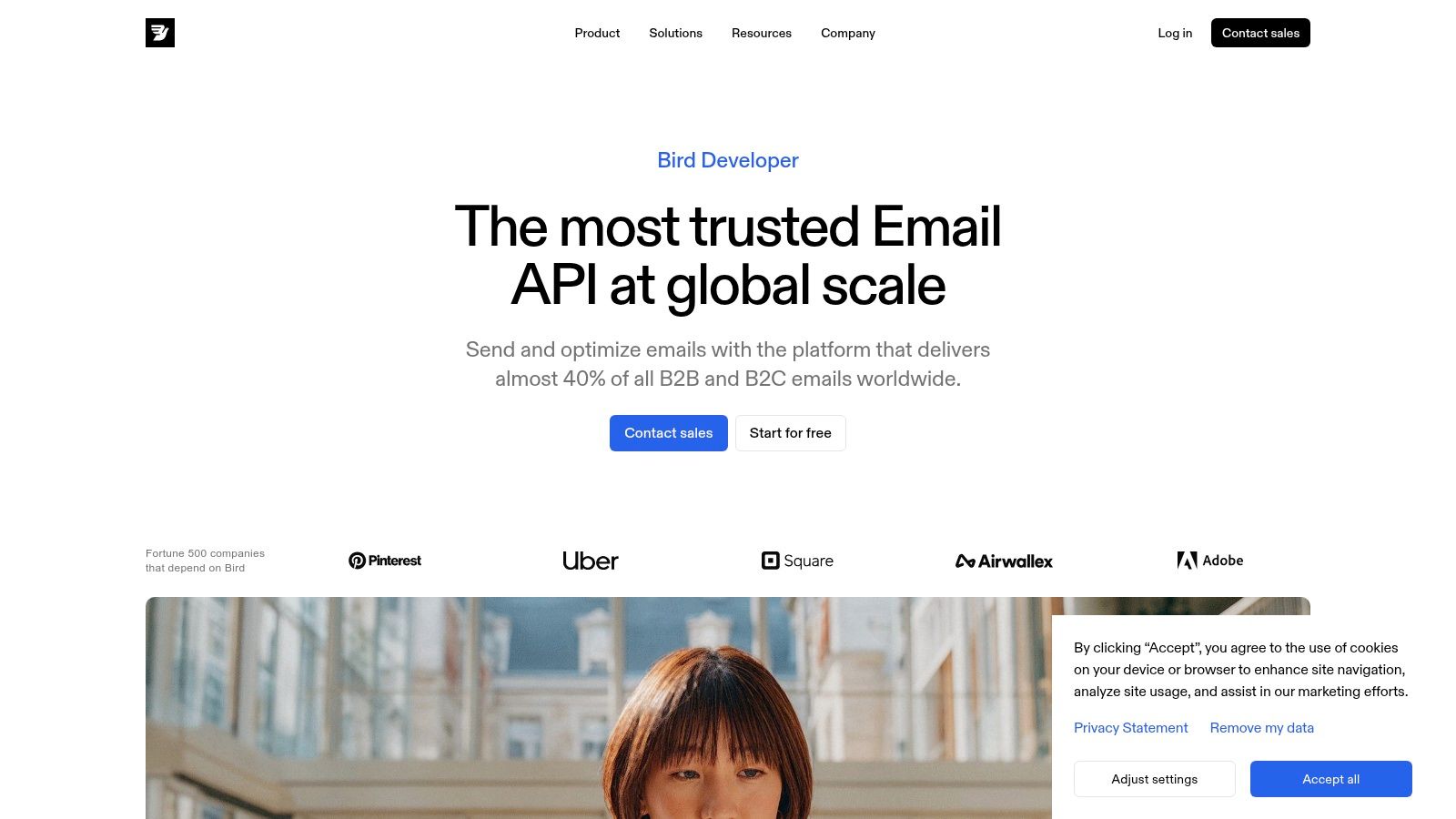
The platform distinguishes itself with its advanced analytics platform, Signals, which provides deep insights into email performance and deliverability health. It allows users to send via SMTP or a comprehensive REST API, offering flexibility for integration into various applications. SparkPost is one of the best bulk email services for enterprises that depend on strong performance SLAs and granular data to optimize their sending strategy.
Key Features and Considerations
SparkPost’s architecture is tailored for developers, offering detailed documentation and webhooks for real-time event tracking. Its pricing is tiered based on volume, with Premier plans including features like dedicated IP addresses and automated warm-up services to protect and build sender reputation. While it offers a limited free tier for testing, its true value is unlocked at higher sending volumes.
Best For:
- Large enterprises and high-volume senders needing performance guarantees.
- Developers integrating email into applications via API.
- Businesses requiring advanced deliverability analytics and reporting.
| Feature | Details |
|---|---|
| Pricing Model | Tiered monthly plans based on volume, with clear overage rates. |
| Primary Use Case | API-driven transactional and marketing emails at scale. |
| Technical Skill Required | Moderate to High; comfortable with API integration and DNS setup. |
| Deliverability Tools | Signals analytics platform, dedicated IPs, and automated warm-up (Premier). |
Pros:
- Strong performance SLAs ensure reliable delivery.
- Advanced analytics provide deep insights into deliverability.
- Competitive and predictable pricing for high-volume users.
Cons:
- The user interface and feature set are split between different plan tiers.
- The free developer tier is very limited and intended mainly for testing.
Website: https://www.sparkpost.com/
9. Mailchimp
Mailchimp is one of the most recognized all-in-one email marketing platforms, famous for its user-friendly interface and comprehensive feature set. It excels at helping businesses of all sizes create, send, and analyze email campaigns without requiring technical expertise. Its drag-and-drop editor, pre-built templates, and powerful segmentation tools make it an accessible entry point for those new to email marketing.
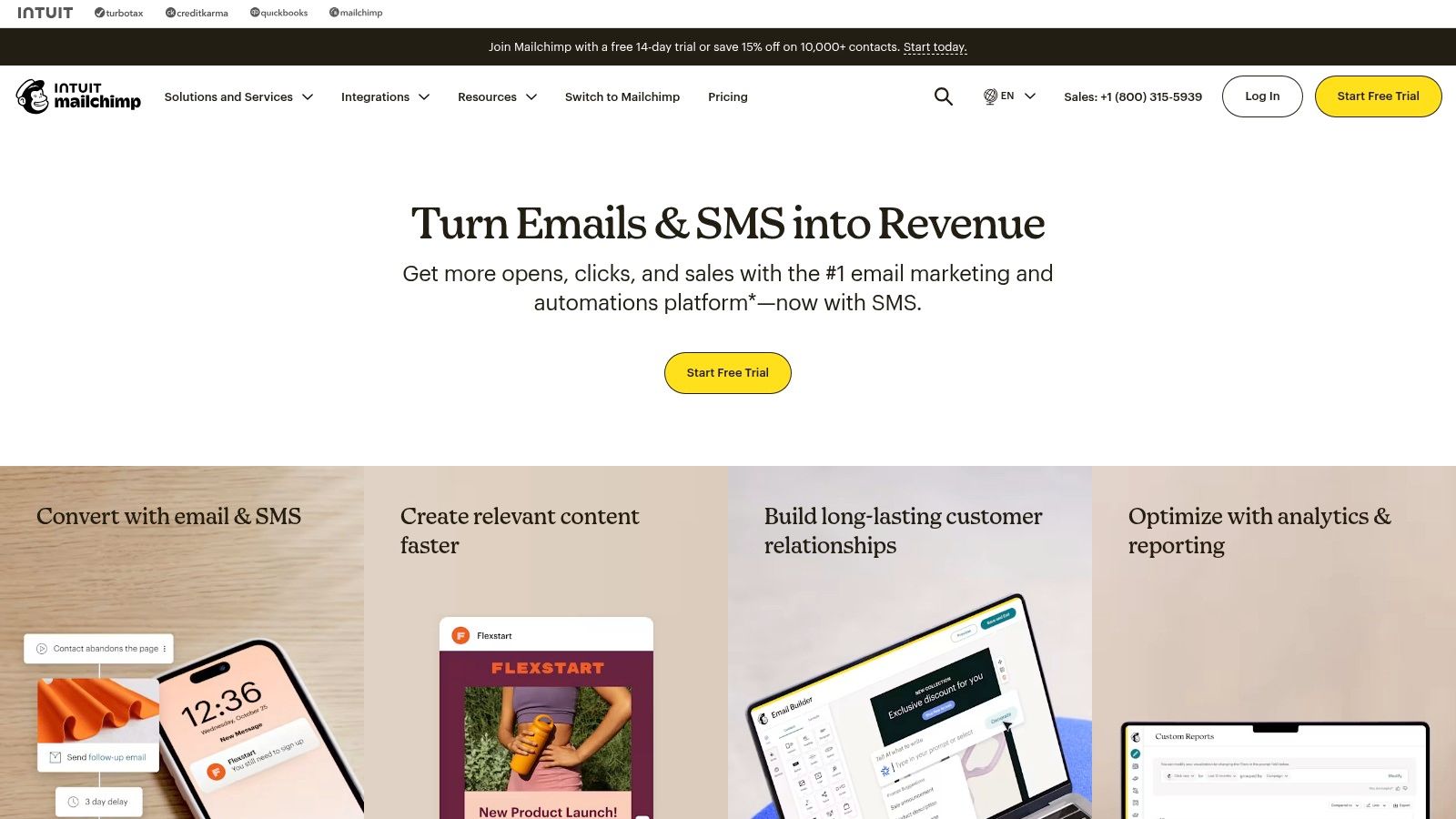
The platform has evolved from a simple newsletter tool into a full marketing suite with automation, landing pages, and AI-powered creative assistants. While it’s not primarily a high-volume transactional sender, its add-on solutions and pay-as-you-go credits offer flexibility for less frequent bulk sends. For a deeper analysis of how it stacks up against others, you can find a helpful email marketing platform comparison on b2bemailverifier.com.
Key Features and Considerations
Mailchimp’s strength lies in its approachable design, making it one of the best bulk email services for teams that prioritize ease of use and campaign management over pure sending infrastructure. Its pricing model is based on contact count and feature tiers, which can become expensive for very large lists but provides predictable costs for growing businesses.
Best For:
- Small to medium-sized businesses and startups.
- Marketing teams needing an all-in-one campaign management tool.
- Users who value a polished interface and strong reporting features.
| Feature | Details |
|---|---|
| Pricing Model | Tiered subscription based on contact count; pay-as-you-go credits available. |
| Primary Use Case | Marketing newsletters, automated drip campaigns, and audience segmentation. |
| Technical Skill Required | Low; designed for non-technical users with an intuitive interface. |
| Deliverability Tools | Audience management, A/B testing, and built-in analytics and reporting. |
Pros:
- Extremely approachable and easy for new teams to adopt.
- Excellent reporting, analytics, and pre-designed templates.
- Scales well for growing contact lists with robust automation features.
Cons:
- Pricing can become expensive at scale compared to infrastructure-focused services.
- Transactional email requires a separate add-on (Mandrill) or third-party integration.
Website: https://mailchimp.com/
10. Constant Contact
Constant Contact is an all-in-one digital marketing platform designed primarily for small to medium-sized businesses, nonprofits, and entrepreneurs. While it offers a broad suite of tools, its core strength lies in its approachable email marketing capabilities. The platform excels at empowering non-technical users to create, send, and track professional email campaigns without a steep learning curve, making it one of the best bulk email services for organizations that need more than just an email sender.
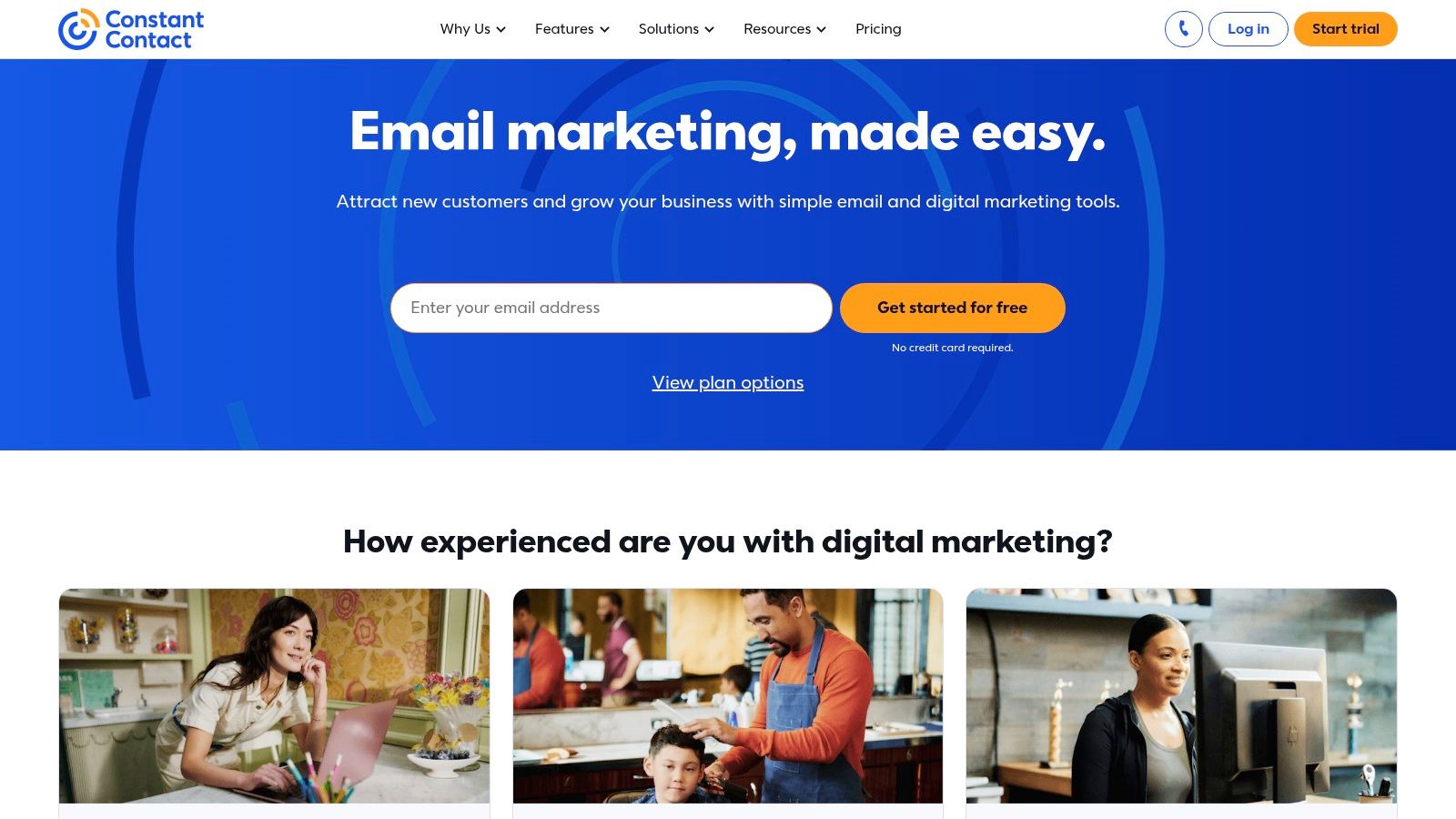
Unlike purely technical services, Constant Contact focuses on user experience with an intuitive drag-and-drop editor, a vast library of customizable templates, and straightforward automation workflows. This focus on ease of use extends to its other features, including social media posting, event management, and SMS marketing add-ons. It's a comprehensive solution for businesses that want to manage multiple marketing channels from a single, unified dashboard.
Key Features and Considerations
Constant Contact's platform is built around simplicity and support. The pricing is tiered based on the number of contacts in your list, which allows businesses to scale their investment as their audience grows. Strong customer support, including phone and chat, is a key differentiator, providing a safety net for users who may not be marketing experts.
Best For:
- Small businesses and nonprofits needing an easy-to-use platform.
- Users who value strong customer support and onboarding.
- Marketers looking for an integrated solution with social media and event tools.
| Feature | Details |
|---|---|
| Pricing Model | Tiered pricing based on the number of contacts. |
| Primary Use Case | Email newsletters, marketing automation, and integrated digital campaigns. |
| Technical Skill Required | Low; designed for non-technical users with an intuitive interface. |
| Deliverability Tools | List segmentation, A/B testing, and campaign performance reporting. |
Pros:
- Extremely user-friendly and easy to set up.
- Excellent customer support and educational resources.
- Good for non-technical teams running recurring campaigns.
Cons:
- Pricing can become expensive as list size grows.
- Limited advanced automation and developer-centric API features.
Website: https://www.constantcontact.com/
11. Campaign Monitor
Campaign Monitor is a premium email marketing platform known for its beautiful, designer-friendly templates and intuitive interface. It caters to businesses and marketing agencies that prioritize aesthetics and brand consistency in their email campaigns. Unlike purely functional tools, Campaign Monitor blends powerful automation with award-winning design capabilities, making it easy to create visually stunning newsletters and customer journeys.
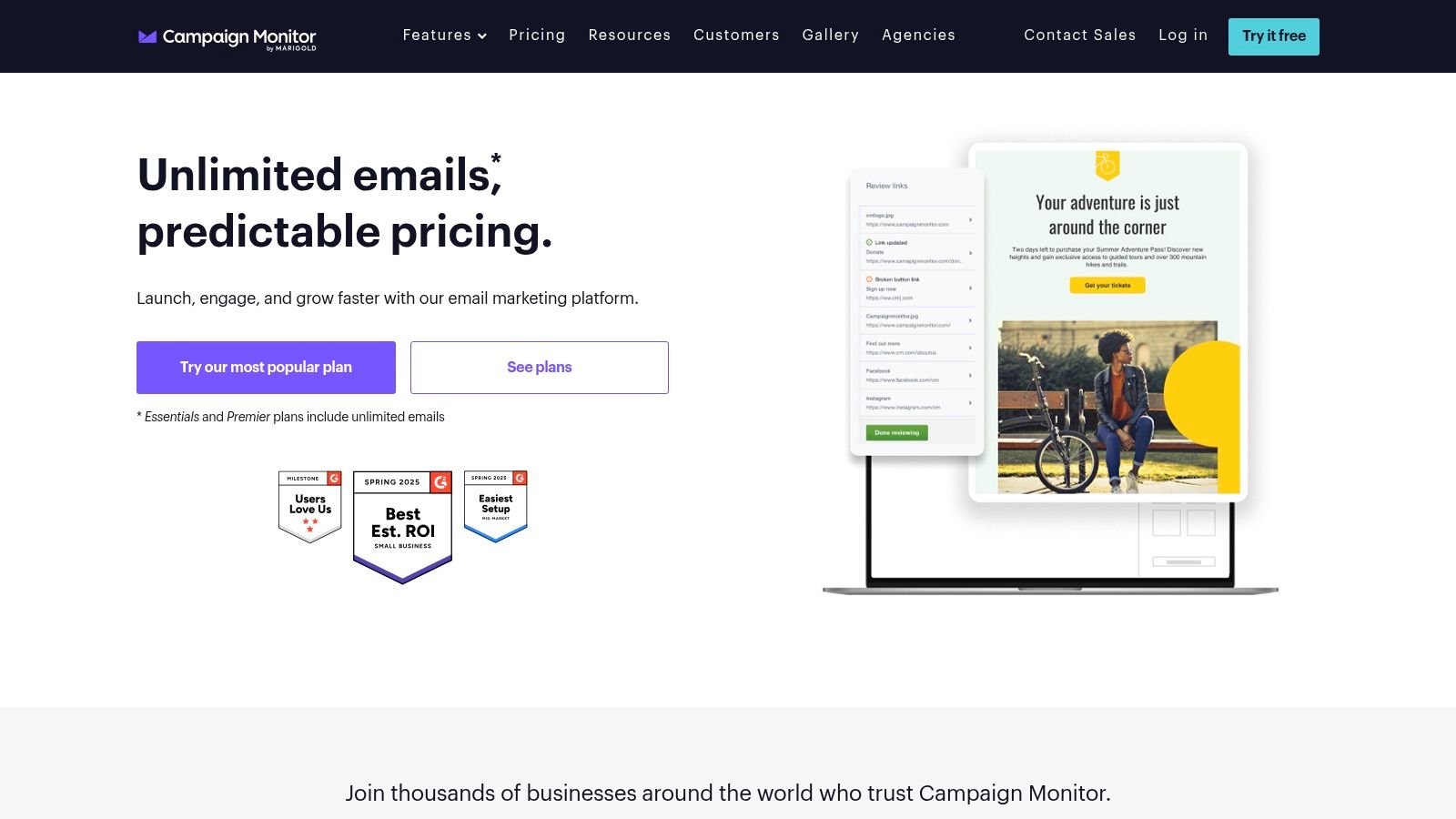
The platform is built for marketers, not developers, offering a seamless user experience from campaign creation to performance analysis. Its visual journey builder allows users to map out automated email sequences based on subscriber behavior, while its agency-specific features provide tools for managing multiple clients under a single account, complete with custom branding and billing management.
Key Features and Considerations
Campaign Monitor’s pricing is contact-based, which can become costly for users with very large lists, but the value is justified for those who need a polished, reliable solution. Its strength lies in marketing-focused campaigns rather than high-volume transactional emails, making it one of the best bulk email services for brands that value design and user engagement over raw sending power.
Best For:
- Marketing agencies managing multiple client accounts.
- Businesses focused on creating visually rich newsletters and campaigns.
- Marketers who need an intuitive, easy-to-use automation builder.
| Feature | Details |
|---|---|
| Pricing Model | Tiered plans based on the number of contacts; scales up. |
| Primary Use Case | Marketing automation, newsletters, and agency client management. |
| Technical Skill Required | Low; designed for marketers with a user-friendly drag-and-drop interface. |
| Deliverability Tools | Strong sender reputation, engagement tracking, and list segmentation. |
Pros:
- Exceptionally clean UI and professionally designed templates.
- Robust features tailored for marketing agencies.
- Solid deliverability and reliable performance.
Cons:
- Can be more expensive than competitors, especially at scale.
- Transactional email and API capabilities are less robust than specialized services.
Website: https://www.campaignmonitor.com/
12. MailerLite
MailerLite is a user-friendly and budget-conscious email marketing platform that combines traditional bulk sending with a suite of digital marketing tools. It's designed for small to medium-sized businesses, bloggers, and creators who need more than just an email sender. The platform extends its functionality to include a website builder, landing pages, and pop-up forms, making it an excellent all-in-one solution for those looking to build their online presence without a steep learning curve.
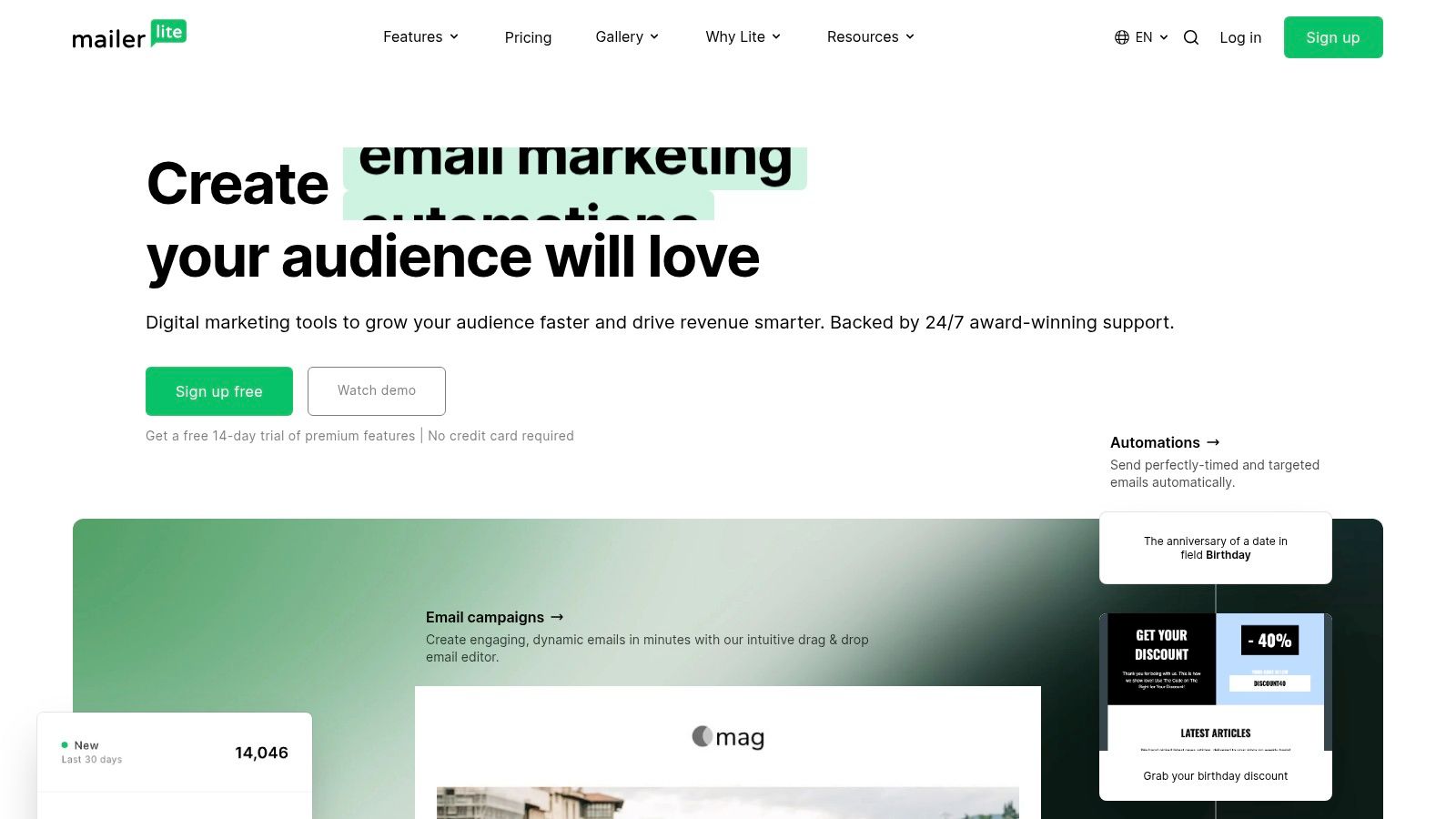
The platform is celebrated for its clean, intuitive interface that simplifies campaign creation and automation. While it excels at newsletters and standard broadcasts, it also offers transactional email as an add-on, allowing users to manage all their sending needs under one roof. This combination of simplicity, affordability, and comprehensive features solidifies its position as one of the best bulk email services for growing businesses.
Key Features and Considerations
MailerLite's core appeal lies in its generous feature set at competitive price points, including unlimited email sends on all paid plans. It provides essential tools like A/B testing and basic automation, making it accessible for users who are new to email marketing but powerful enough for those scaling their efforts. The built-in asset creators are a significant value-add, removing the need for separate subscriptions for landing pages or websites.
Best For:
- Small businesses, freelancers, and content creators.
- Users who prioritize ease of use and an all-in-one marketing toolkit.
- Budget-conscious marketers looking for a strong feature set.
| Feature | Details |
|---|---|
| Pricing Model | Tiered based on subscriber count; offers a free plan for up to 1,000 subscribers. |
| Primary Use Case | Email newsletters, marketing automation, and building landing pages. |
| Technical Skill Required | Low; features a drag-and-drop editor and intuitive workflows. |
| Deliverability Tools | Click maps, open rate tracking, and dedicated IP options on higher plans. |
Pros:
- Competitive pricing, especially for growing email lists.
- Straightforward, easy-to-use interface and campaign editor.
- Includes website, blog, and landing page builders.
Cons:
- Fewer enterprise-level deliverability features compared to API-first platforms.
- Advanced automation is gated to higher-priced tiers.
Website: https://www.mailerlite.com/
Top 12 Bulk Email Services Feature Comparison
| Platform | Core Features | User Experience & Quality | Value Proposition | Target Audience | Price Points & Plans |
|---|---|---|---|---|---|
| Amazon Simple Email Service (SES) | High-volume email, dedicated IPs, AWS integration | Reliable infrastructure, technical setup | Extremely low per-message costs | Developers, enterprises | Pay-as-you-go, volume tiers |
| Twilio SendGrid | Email API, marketing campaigns, analytics | Easy to start, broad integrations | Scalable with free plan available | Marketers, developers | Free plan, scalable paid tiers |
| Mailgun | Developer API, inbound routing, detailed logs | Programmatic focus, clear scaling | Strong sending and parsing support | Developers | Scalable plans, no daily caps |
| Brevo (formerly Sendinblue) | Multichannel (email, SMS, WhatsApp), automation | Intuitive UI, strong automation | Affordable, good SMB fit | SMBs, marketers | Contact-based pricing, prepaid credits |
| Sinch Mailjet | API + editor, collaboration, segmentation | Team collaboration, simple pricing | Good team features | Marketing teams | Free tier with limits, paid tiers |
| Elastic Email | Email API, verification, dedicated IPs | Competitive pricing, basic UI | Built-in verification, high volume | Cost-conscious senders | Low cost, plans with verification |
| Postmark (by ActiveCampaign) | Transactional & broadcast emails, fast delivery | Transparent pricing, speed focused | Excellent deliverability | Developers, transactional | Free tier, pay-as-you-go |
| SparkPost (by Bird/MessageBird) | APIs, advanced analytics, SLAs, dedicated IPs | Strong SLA, competitive pricing | High volume, reliable | Enterprises, developers | Free test tier, tiered paid plans |
| Mailchimp | Drag-drop builder, automation, templates | User-friendly, strong reporting | All-in-one marketing suite | Marketers, SMBs | Scales with contacts, add-ons needed |
| Constant Contact | Automation, SMS, social posting, templates | Easy setup, strong support | Best for SMBs, non-technical teams | SMBs | Tiered by list size |
| Campaign Monitor | Design tools, automation, integrations | Designer friendly, clean UI | Agency features, strong deliverability | Agencies, marketers | Contact-based pricing |
| MailerLite | Automation, landing pages, transactional email | Easy-to-use, budget-friendly | Great for newsletters & bulk email | Small businesses, beginners | Competitive pricing, unlimited emails |
Making Your Final Choice: A Note on Deliverability
Navigating the landscape of the best bulk email services can feel overwhelming, but the right choice always comes down to your unique operational needs. We've explored a wide range of platforms, from powerful, API-first engines to user-friendly marketing suites. Your decision is the critical first step in building a successful email program.
As we've seen, services like Amazon SES and Twilio SendGrid offer unparalleled scalability and control for development teams comfortable working with APIs. In contrast, platforms like Mailchimp and Brevo provide integrated, all-in-one solutions that empower marketing teams to manage campaigns, segmentation, and analytics without writing a single line of code. The key is to match the tool to your team's skillset and your campaign's goals.
How to Choose Your Ideal Service
To distill everything down, here is a simple framework to guide your final decision. Ask yourself these critical questions:
- What is my primary use case? Are you sending transactional emails (password resets, receipts), large-scale marketing newsletters, or a mix of both? Tools like Postmark excel at transactional delivery, while Campaign Monitor is built for beautiful marketing campaigns.
- What are my team's technical skills? If you have developers ready to integrate an API, services like Mailgun or SparkPost offer robust, flexible solutions. If not, a platform with a drag-and-drop editor and a clear user interface like MailerLite or Constant Contact is a much better fit.
- What is my budget and sending volume? Your sending frequency and list size will heavily influence costs. For high-volume senders, the pay-as-you-go models of Amazon SES or Elastic Email can be incredibly cost-effective. For those starting out, a service with a generous free tier, like Brevo, might be the perfect entry point.
- What features are non-negotiable? Do you absolutely need advanced automation, built-in CRM functionality, or detailed A/B testing? Create a checklist of your must-have features and cross-reference it with our reviews to narrow down your top contenders.
The Unifying Factor: Your Email List Quality
No matter which of the best bulk email services you select, its performance is fundamentally tied to one thing: the health of your email list. The most advanced sending infrastructure in the world cannot overcome a list filled with invalid, outdated, or risky email addresses.
Sending to a low-quality list results in high bounce rates, which is a major red flag for Internet Service Providers (ISPs) like Gmail and Outlook. This immediately damages your sender reputation, making it more likely that your future emails will land in the spam folder, or worse, be blocked entirely. Many of the services we've covered will even suspend your account for consistently high bounce rates to protect their own network integrity.
Before you invest time and money into a new platform, invest in your data. To maintain a high sender reputation and ensure your emails reach the inbox, it's crucial to regularly clean your lists and utilize an email verifier service. This process scrubs your list of undeliverable addresses, spam traps, and other problematic contacts, providing a clean foundation for your campaigns. A verified list is not just a recommendation; it's a prerequisite for success in modern email marketing.
By choosing a service that aligns with your goals and pairing it with a commitment to list hygiene, you create a powerful engine for growth. You equip yourself to build meaningful connections, drive conversions, and achieve a powerful return on your email marketing investment. The right tool, powered by clean data, is your key to unlocking the full potential of the inbox.

